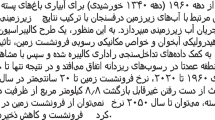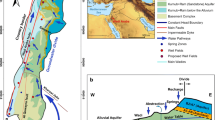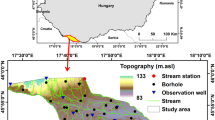Abstract
The unconfined aquifer beneath the Aliabad plain is one of the few freshwater resources in northwestern Qom province in Iran. Land subsidence in the Aliabad plain is primarily the result of extensive overexploitation of groundwater resources and successive droughts. The harmful effects of overexploitation include significant socioeconomic consequences and severe damage to aquifers. The current study proposes an accurate scenario model that reduces the overall land subsidence by assessing different scenarios for future groundwater exploitation in the plain. The quantitative model consists of 120 time-steps over a period of 10 years (2006–2016). Model validation was achieved by comparing the calculated groundwater level variations with the results of piezometric evaluations in modeling. The results of the validated model were used to predict variations in the aquifer hydraulic head caused by changes in exploitation under different scenarios. Modeling of the Aliabad plain revealed that a 10% decrease in pumping will reduce and stabilize the groundwater decline and a 30% reduction will help recharge the aquifer. The model simulation was able to predict critical land subsidence of 35 cm by 2016. The geometric location of maximum land subsidence was predicted by comparing the geometric distribution of predicted land subsidence patterns with subsidence results from radar interferometry. Prediction of land subsidence by 2026 indicated that management of the exploitation of resources and strict aquifer stabilization programs can reduce the damage to the aquifer.











Similar content being viewed by others
References
Amighpey M, Arabi S (2016) Studying land subsidence in Yazd province Iran, by integration of InSAR and levelling measurements. Remote Sens Appl Soc Environ. https://doi.org/10.1016/j.rsase.2016.04.001
Anderson MP, Woessner WW (1992) The role of the postaudit in model validation. Adv Water Resour 15:167–173
Aquaveo (2017) GMS 10.3 Tutorials Environmental Modeling Research Laboratory. Brigham Young University, Provo
Bajni G, Apuani T, Beretta GP (2019) Hydro-geotechnical modelling of subsidence in the Como urban area. Eng Geol 257:105144. https://doi.org/10.1016/j.enggeo.2019.105144
Bakker M, Hemker K (2004) Analytic solutions for groundwater whirls in box-shaped, layered anisotropic aquifers. Adv Water Resour 27:1075–1086
Bell JW (1981) Subsidence in Las Vegas Valley. University of Nevada, Mackay School of Mines, Reno
Biot M (1941) The general three-dimensional consolidation theory. J Appl Phys 12:155–164
Budhu M (2011) Earth fissure formation from the mechanics of groundwater pumping. Int J Geomech 11:1–11
Chan Y, Mullineux N, Reed J, Wells G (1978) Analytic solutions for drawdowns in wedge-shaped artesian aquifers. J Hydrol 36:233–246
Chiang W-H (2005) 3D-Groundwater modeling with PMWIN: a simulation system for modeling groundwater flow and transport processes. Springer Science & Business Media, Berlin
Cui Y, Su C, Shao J, Wang Y, Cao X (2014) Development and application of a regional land subsidence model for the plain of Tianjin. J Earth Sci 25:550–562
Dehghani M, Valadan Zoej MJ, Hooper A, Hanssen RF, Entezam I, Saatchi S (2013) Hybrid conventional and Persistent Scatterer SAR interferometry for land subsidence monitoring in the Tehran Basin. Iran. ISPRS J Photogramm Remote Sens 79:157–170. https://doi.org/10.1016/j.isprsjprs.2013.02.012
Demenico P, Schwartz F (1990) Physical and chemical hydrogeology. Wiley, New York
Diersch H (2005) FEFLOW finite element subsurface flow and transport simulation system. Institute for Water Resources Planning and System Research, Berlin
Edalat A, Khodaparast M, Rajabi AM (2020) Detecting land subsidence due to groundwater withdrawal in Aliabad plain, Iran, using ESA Sentinel-1 satellite data. Nat Resour Res 29:1935–1950. https://doi.org/10.1007/s11053-019-09546-w
ESA (2016) Sentinel-1 scientific data hub. European Space Agency. Available at: https://scihub.copernicus.eu/dhus
Galloway DL, Burbey TJ (2011) Review: Regional land subsidence accompanying groundwater extraction. Hydrogeol J 19:1459–1486. https://doi.org/10.1007/s10040-011-0775-5
Hoffmann J, Leake SA, Galloway DL, Wilson AM (2003) MODFLOW-2000 ground-water model—user guide to the subsidence and aquifer-system compaction (SUB) package. Geological Survey, Washington DC
Hu L et al (2019) Land subsidence in Beijing and its relationship with geological faults revealed by Sentinel-1 InSAR observations. Int J Appl Earth Obs Geoinf 82:101886. https://doi.org/10.1016/j.jag.2019.05.019
Karimi L, Motagh M, Entezam I (2019) Modeling groundwater level fluctuations in Tehran aquifer: results from a 3D unconfined aquifer model. Groundwater Sustain Dev 8:439–449
Karimipour AR, Rakhshanderoo G (2011) Sensitivity analysis for hydraulic behavior of Shiraz plain aquifer using PMWIN. Water Wastewater 22:102–111
Konikow LF, Kendy E (2005) Groundwater depletion: A global problem. Hydrogeol J 13:317–320
Lashkaripour GR, Ghafoori M (2011) The effects of water table decline on the groundwater quality in aquifer of Torbat Jam Plain, Northeast Iran. Int J Emerg Sci 1:153–163
Ma P, Wang W, Zhang B, Wang J, Shi G, Huang G, Chen F, Jiang L, Lin H (2019) Remotely sensing large- and small-scale ground subsidence: a case study of the Guangdong-Hong Kong–Macao Greater Bay Area of China. Remote Sens Environ 232:111282. https://doi.org/10.1016/j.rse.2019.111282
Mahdavi M, Farokhzadeh B, Salajegheh A, Malakian A, Souri M (2013) Simulation of Hamedan-Bahar aquifer and investigation of management scenarios by using PMWIN. Whatershed Manag Res 26:108–116
Mahmoudpour M, Khamehchiyan M, Nikudel M, Ghassemi M (2016) Numerical simulation and prediction of regional land subsidence caused by groundwater exploitation in the Southwest Plain of Tehran, Iran. Eng Geol 201:6–28. https://doi.org/10.1016/j.enggeo.2015.12.004
McDonald MG, Harbaugh AW (1988) A modular three-dimensional finite-difference ground-water flow model. US Geological Survey, Reston
Moe IR, Kure S, Januriyadi NF, Farid M, Udo K, Kazama S, Koshimura S (2017) Future projection of flood inundation considering land-use changes and land subsidence in Jakarta, Indonesia. Hydrol Res Lett 11:99–105
Motagh M, Djamour Y, Walter TR, Wetzel H-U, Zschau J, Arabi S (2007) Land subsidence in Mashhad Valley, northeast Iran: results from InSAR, levelling and GPS. Geophys J Int 168:518–526. https://doi.org/10.1111/j.1365-246X.2006.03246.x
Nash JE, Sutcliffe JV (1970) River flow forecasting through conceptual models part I—a discussion of principles. J Hydrol 10:282–290
Office of Water and Abfa Operating and Protection Systems (2012) Groundwater balancing program. Ministry of Energy, Deputy Minister of Water and Abfa, Delhi
Qin H, Andrews CB, Tian F, Cao G, Luo Y, Liu J, Zheng C (2018) Groundwater-pumping optimization for land-subsidence control in Beijing plain, China. Hydrogeol J 26:1061–1081
Qom Regional Water Company (2000) Geophysical studies of Qom province. Ministry of Energy, Iran Water Resources Management Company, Tehran
Qom Regional Water Company (2013) Water resources report of Saveh study area Abkhan consulting engineers. Ministry of Energy, Iran Water Resources Management Company, Tehran
Qom Regional Water Company (2016) Information on observation wells and exploitation wells in Aliabad plain of Qom (4112 study area). Ministry of Energy, Iran Water Resources Management Company, Tehran
Rahnama MB, Moafi H (2009) Investigation of land subsidence due to groundwater withdraw in Rafsanjan plain using GIS software. Arab J Geosci 2:241–246. https://doi.org/10.1007/s12517-009-0034-4
Rajabi AM (2018) A numerical study on land subsidence due to extensive overexploitation of groundwater in Aliabad plain, Qom-Iran. Nat Hazards 93:1085–1103. https://doi.org/10.1007/s11069-018-3448-z
Rajabi AM, Ghorbani E (2016) Land subsidence due to groundwater withdrawal in Arak plain, Markazi province, Iran. Arab J Geosci 9:738
Regli C, Rauber M, Huggenberger P (2003) Analysis of aquifer heterogeneity within a well capture zone, comparison of model data with field experiments: a case study from the river Wiese, Switzerland. Aquat Sci 65:111–128
Rodolfo KS, Siringan FP (2006) Global sea-level rise is recognised, but flooding from anthropogenic land subsidence is ignored around northern Manila Bay, Philippines. Disasters 30:118–139
Terzaghi K (1925) Principles of soil mechanics, IV—Settlement and consolidation of clay. Eng News Rec 95:874–878
Willmott CJ, Wicks DE (1980) An empirical method for the spatial interpolation of monthly precipitation within California. Phys Geogr 1:59–73
Author information
Authors and Affiliations
Corresponding author
Additional information
Publisher's Note
Springer Nature remains neutral with regard to jurisdictional claims in published maps and institutional affiliations.
Rights and permissions
About this article
Cite this article
Edalat, A., Khodaparast, M. & Rajabi, A.M. Scenarios to control land subsidence using numerical modeling of groundwater exploitation: Aliabad plain (in Iran) as a case study. Environ Earth Sci 79, 494 (2020). https://doi.org/10.1007/s12665-020-09246-2
Received:
Accepted:
Published:
DOI: https://doi.org/10.1007/s12665-020-09246-2




